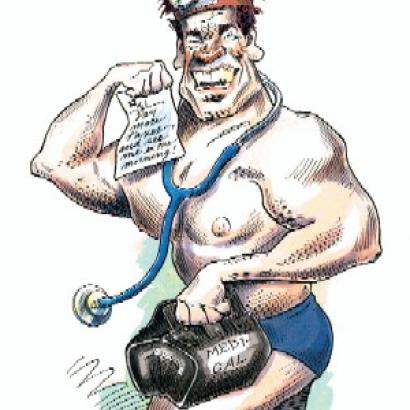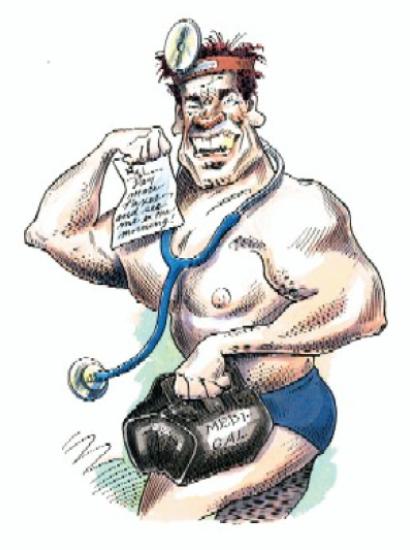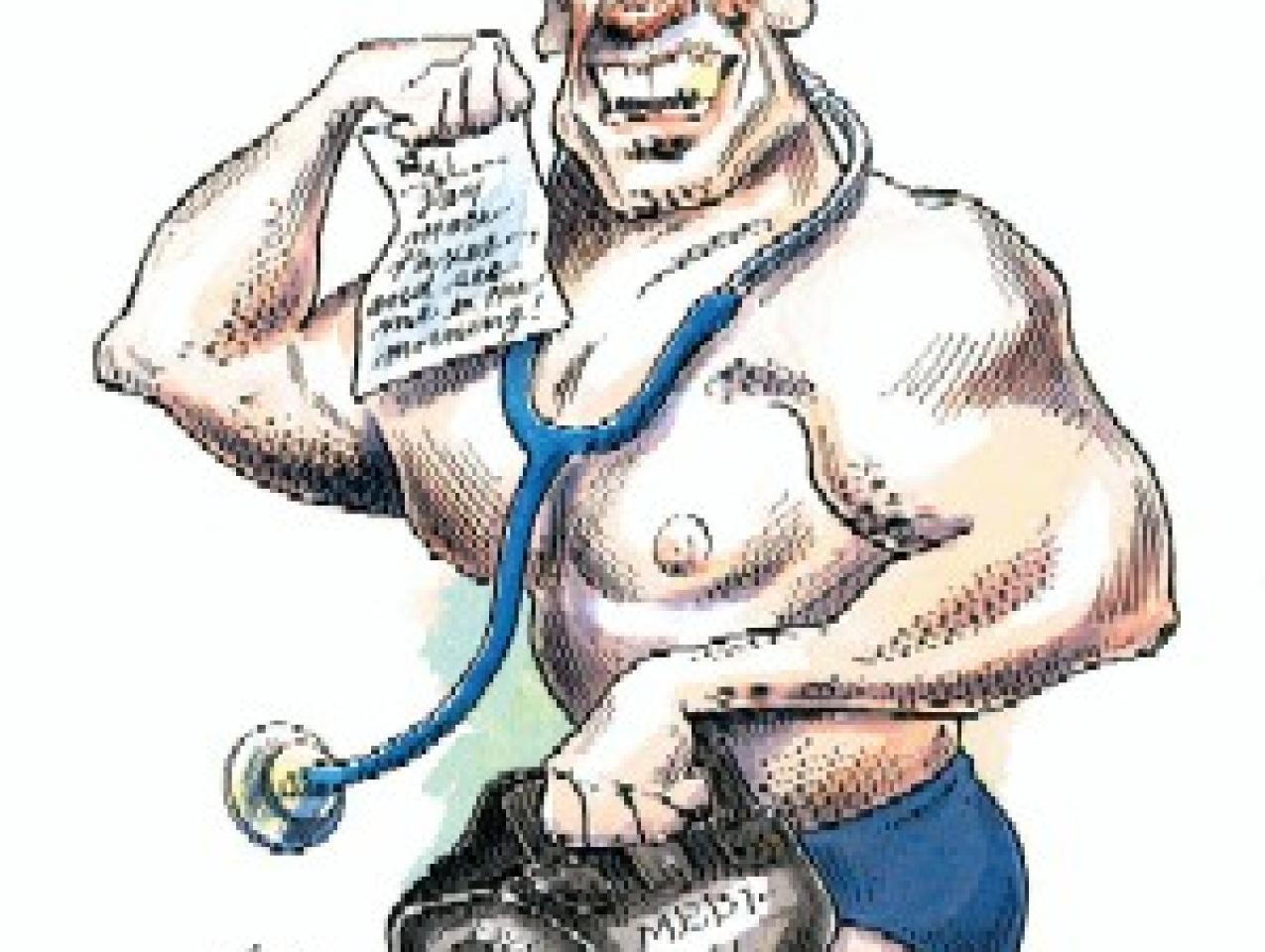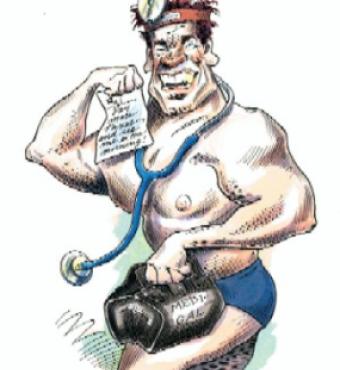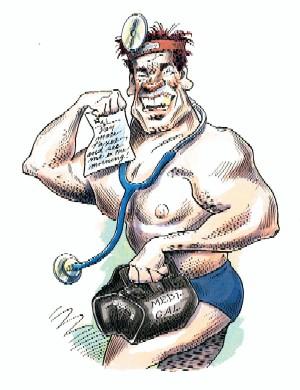- Budget & Spending
- State & Local
- The Presidency
- Economics
- Politics, Institutions, and Public Opinion
On January 9, Governor Arnold Schwarzenegger presented his proposal for reducing the number of Californians who lack health insurance. His proposal is almost indistinguishable—except in details—from that of the Democrats who dominate the California Assembly and Senate.
The Democrats tend to favor solutions involving regulations, government spending, and taxes, and Senate president pro tem Don Perata’s proposal—the main contending Democrat plan—hits the trifecta. It would require employers to provide health insurance; give them the option of paying a tax instead of providing health insurance; and increase spending by expanding both the Medi-Cal and Healthy Families programs, which provide care to low-income children—including children of illegal immigrants and the disabled.
Schwarzenegger’s solution hits the trifecta also. He would require employers with 10 or more workers to provide health insurance or pay a 4 percent tax on all wages covered by Social Security. Look for employers with 10 to 12 employees to get creative about outsourcing. And look as well, as Harvard economist Jonathan Gruber has documented, for wages to fall in firms that offer health insurance because of the mandate. Governor Schwarzenegger would throw in a 2 percent tax on doctors and a 4 percent tax on hospitals to help fund Medi-Cal, California’s name for Medicaid. And he would expand Medi-Cal to adults earning as much as 100 percent above the poverty line and to children, even those here illegally, in poor and middle-income families. He hopes, by doing this, to shift $5 billion of Medi-Cal’s annual cost to the federal government.
| What if the governor could help the uninsured by making health insurance cheaper? He cannot by regulating more, but by deregulating. |
There are two problems with such solutions. First, they infringe on economic freedom, preventing, in Robert Nozick’s phrase, “capitalist acts between consenting adults.” Second, government solutions rarely work.
Why doesn’t increased government power tend to solve the problem of the uninsured? One reason is that when government provides health insurance, many people who take advantage of it drop their own privately provided health insurance. In a 1996 article in the Quarterly Journal of Economics, Harvard economists David M. Cutler and Jonathan Gruber found a 50 percent “crowding-out effect.” As the federal Medicaid program expanded, for every two people who gained insurance through Medicaid, one dropped private health insurance. Although this is a net addition of one, the costs to taxpayers are much higher than expected because now half of the newly covered, instead of paying their own way as they previously did, become wards of the state.
Moreover, the problem of the uninsured should not be exaggerated. It’s true that at any given time, about 15 percent of the population, illegal and legal, lacks health insurance. But of the 46 million or so people without health insurance at any given time, about 45 percent will have health insurance within four months. This is one of the main findings of a 2003 study by the Congressional Budget Office, “How Many People Lack Health Insurance and for How Long?” which estimated that between 21 million and 31 million people were uninsured for the entire year in 1998, the most recent year for which good data were available. Moreover, the CBO’s analysis showed that, contrary to the stereotype, 42 percent of uninsured spells among people with income below 200 percent of the poverty level end within four months, and only about one-third last more than a year. That shouldn’t be surprising in a country where most private health insurance is employer-provided and most unemployment spells last 11 weeks or less. Solutions that involve government mandates on employers or employees will, therefore, miss connecting with about half of the people who are uninsured at a given time.
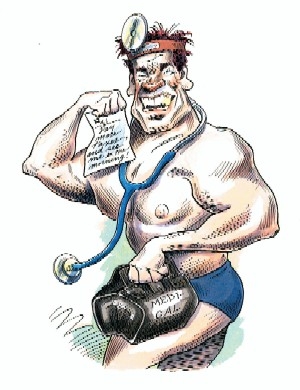
But what if the governor could help the uninsured by making health insurance cheaper? He can—not by regulating more but by deregulating.
Let me explain. In the past few decades, state governments, the main regulators of health insurance in the individual and small-group markets, have mandated coverages for many kinds of health care. According to the Council for Affordable Health Insurance (CAHI), a promarket association of insurance carriers, there were 1,843 state mandates in 2006. Among the most common mandates are chiropractic care, treatment for alcoholism and drug abuse, and mental health benefits. California’s government mandates coverage for all of the above, as well as for many other benefits, including, for example, infertility treatment—a very expensive benefit.
Abolishing these mandates would allow people who don’t want to be covered for these things to buy cheaper insurance, while still allowing those who want them to buy and pay for them. Would such an approach work? That’s like asking whether, if the government currently required new cars to have CD players, eliminating that requirement would lower the price of a car. Of course it would work.
| When government provides health insurance, many people who take advantage of it drop their own privately provided health insurance. The newly covered, instead of paying their own way as they previously did, become wards of the state. |
It is important, though, not to overstate its benefits. The gain to Californians from abolishing these mandates would not be huge. CAHI compiled data from America’s Health Insurance plan and eHealthInsurance for the individual market and from the federal government for the small-group market and found that in 2003, although California had more mandated coverages than all but six other states, it had among the lowest insurance rates for individual health insurance policies ($1,885 versus a top rate of $6,048 for New Jersey).
The reason, explains CAHI, is that in other ways California is much less regulatory than many other states. It does not, for example, require guaranteed issues of individual policies—which drives up premiums by forcing insurance companies to supply policies to all comers, regardless of health status. Yet the governor’s proposal would reverse this and prevent insurance companies from saying no because of age or health.
California should not, contra Governor Schwarzenegger, do new regulatory harm; rather it should repeal existing regulations that cause harm—so as to make health insurance even more affordable.
| Of the 46 million or so people without health insurance at any given time, about 45 percent will have health insurance within four months. |
There is one other way to deregulate: The California government could allow any Californian to buy health insurance from any willing insurer in any state and be subject to the regulations of that state. That way, people could shop for the degree of paternalism they want. If they want insurance from a state that requires many things to be covered, they could do so and pay the high premiums that result. If they want bare-bones coverage, they could do that, also. The result would surely be that some of the current uninsured would buy insurance. Were I in the market for individual insurance and given the choice, I would not bother paying for coverage for alcohol or drug abuse.
If a version of Schwarzenegger’s plan passes, the only thing certain is that there will be more regulation, more government spending, and more taxes. A better path would be to deregulate, and thus achieve some increase in the number of insured—without new spending or taxes or regulation.








